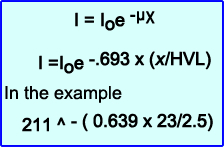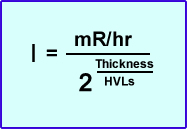- The type of shielding required depends on the type of radiation
- Alpha particles require nothing more that a sheet of paper to be absorbed
- Beta particles require nothing more than a 1/4 inch thick of plastic
- Gamma and x-rays require lead, concrete, or a lot of water
- Applications in nuclear medicine
- Alpha radiation has only one therapeutic application in nuclear medicine
- Some radiopharmaceuticals in nuclear medicine are beta emitters
- Pure beta, such as 32 P would only require plastic for shielding
- A mixed emitter, such as 153Sm or 131I requires a combination of plastic and Pb to achieve adequate shielding. If lead is used without any plastic Bremsstrahlung radiation will occur required
- Shielding material - two points must be considered
- Thickness the thicker the absorber the greater the shielding
- Density - the denser the absorber is the greater the shielding
- Hence the following formula shows the relationship between density of the material and thickness of the material of the same material. Consider this concept as density thickness,
which is also referred to as p/μ

- In addition
- The Z number does not always directly relate to density
- Density changes when the same element is in a solid, liquid, or gaseous state
- Can you think of a good example?
- Attenuation coefficient - is considered a unit for measuring the quantity of radiation being absorbed
- Linear attenuation coefficient (μ)
- Is defined as the amount of or fraction of photons removed from a radiation field per cm of absorber(cm-1)
- Special comment - μ is the analog of the decay constant (λ) and we'll get back to this in just a bit
- The ability for any material to absorb depends on
- Its thickness
- Its density (depends on it state)
- Energy gamma be absorbed
- For our purpose we will only assess μ
- Attenuation in the photoelectric range
- In general, as the energy of gamma radiation increases the interaction with the absorber will have a exponential relationship (just like radiation decay)
- However, If the gamma energy is close to the binding energy of the L or K shell electron of the attenuator, photoelectric effect is less likely to occur and more attenuation will be needed. This is because photon interacts with electron's binding energy
- The L shell interaction occurs at 20 keV and is referred to as the L-edge
- The K shell interaction occurs at 88 keV and is referred to as the K-edge
- Application to Nuclear Medicine? 133Xe (81 keV) and 201Tl (69 - 83 keV), therefore requires more shielding when compared to 99mTc which has a 140 keV gamma
- Consider the relationship – electrons per gram, similar to density, however, electrons replace cm
- The greater the number of electrons per gram the greater the probability that a gamma ray will interact in an absorber via Compton
- Just because an absorber is high in density does not necessary mean that it has a greater number of electrons
- Ag has a density of 10.5 with 2.751 x 1024 electrons
- Pb has a density of 11.35 with 2.701 x 1024 electrons
- Therefore Ag is a better attenuator that Pb
- Why doesn't nuclear medicine use Ag instead of Pb for shielding?
- Interesting point - depleted uranium has greater density and electrons when compared to the above: density = 18.68 and electrons = 4.352 x 1024. When high levels of radiation require shielding, depleted uranium is considered

- The above diagram gives a graphical display on the process in which gamma rays are of attenuated
- Note the relationship between the diagram and the attenuation formula specifically with: I, lo, :, and P
- The behavior of photoelectric, Compton, and pair production can be seen
- Remember, the only way a gamma ray can be attenuated is when it actually reacts with an electron or the nucleus of the atom
- From the above formula
- I = radiation intensity after shielding
- Io = radiation intensity before shielding
- E = natural log of 2 or 0.693
- μ = linear attenuation coefficient in cm-1
- χ = thickness of the shield in cm

Calculation is shown above - If the original gamma intensity is 211 mr/hr for 99mTc, the attenuator (Pb) is 23 mm in thick and has an HVL of 2.5 mm. What is the new gamma intensity? This calculation is similar to the decay formula

Here is one other approach that works just as well when it comes to calculating attenuation. As for the one that you decide you use? Its up to you.
Here are some different HVLs used in nuclear medicine. It is based on energy gamma or photon and density of the attenuator:
| HVL - Attenuator in gm/cm3 | Pb - 11.34 | H2O - 1.0 | NaI - 3.67 |
| 140 keV | 0.0256 cm | 4.53 cm | 0.278 cm |
| 364 keV | 0.219 cm | 6.245 cm | 1.51 cm |
| 511 keV | 0.4021 cm | 7.22 cm | 2.12 cm |
I'm not going to get into the details, but here is the extensive set of formulas that you could apply to decay and attenuation. See PDF file.
Return to the beginning of the document
Return to the Table of Contents